
Friedhelm Schäfer collects timber from the forests of Finland in his Arocs 3263 8x4
Story
Winter is peak season for timber truck drivers in Finland. As a visit to Friedhelm Schäfer and his Arocs demonstrates, this is a challenging job in several ways.
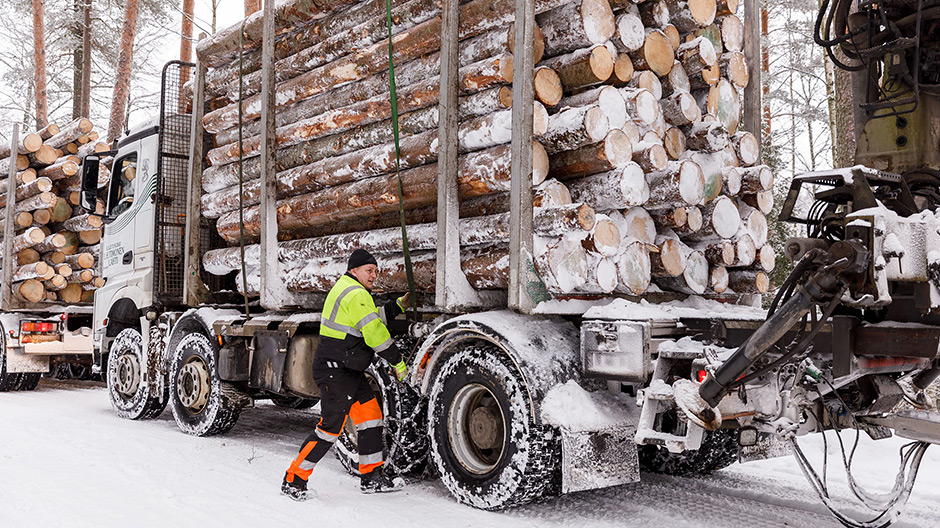
Slippery? Snow on the road isn’t slippery. Things get slippery when the snow thaws – when there is water on the icy roads. But traffic is flowing today, with the speed limit at 80 km/h. Snow is normal for five months of the year. Welcome to the Finnish winter.
Peak season in the forest, which is only accessible to harvesting machinery and lorries once the ground has frozen. Otherwise, their axles sink in the dark, swampy soil.
Friedhelm Schäfer – known to his friends as “Veikko” – sets off near Lahti, which is roughly an hour north of Helsinki. He and his Arocs 3263 8x4 have to deal with all kinds of roads on a daily basis, from main roads and well-maintained minor roads through to back roads that have not been cleared. The forest track comes into view. “We don’t use snow chains very often, but this route hasn’t been cleared. We won’t get very far without them,” explains the 50-year-old as he pulls over.
This article contains additional material (videos, images and reports etc.) for registered RoadStars members. In order to experience the article to the full, you need to log in with your RoadStars account or register for one free of charge.
Become a RoadStar and gain access to exclusive content and campaigns!
Login for RoadStars members
Not yet a member? Join RoadStars now
Obtain exclusive access to exciting events and activities which only RoadStars can offer.
Join RoadStarsFitting snow chains.
He quickly puts on his lined work gloves in order to protect his hands against sharp chain links and the biting cold. He removes the mudguard from the front drive axle, slams the snow chain onto the twin tyres and yanks it into place. He repeats the procedure on the other side before reversing half a metre and fastening the chains – a job that takes barely two minutes in total.
He then drives down the narrow forest trail. He moves manually into fifth, sixth, seventh gear, with the speed of the 640-kilowatt OM 473 remaining constant at 1.800 rpm. The windows are open so that Veikko can hear if the chains become loose. Branches clatter against the mirrors; snow swirls around in the driver’s cabin.
The light grey sky and the white forest road look almost the same. At best, you can only guess whether there is still a trail beneath the snow or whether we have already reached the embankment. Oops! The vehicle slides to the left. Veikko takes his foot off the accelerator and steers the truck sharply back on track.
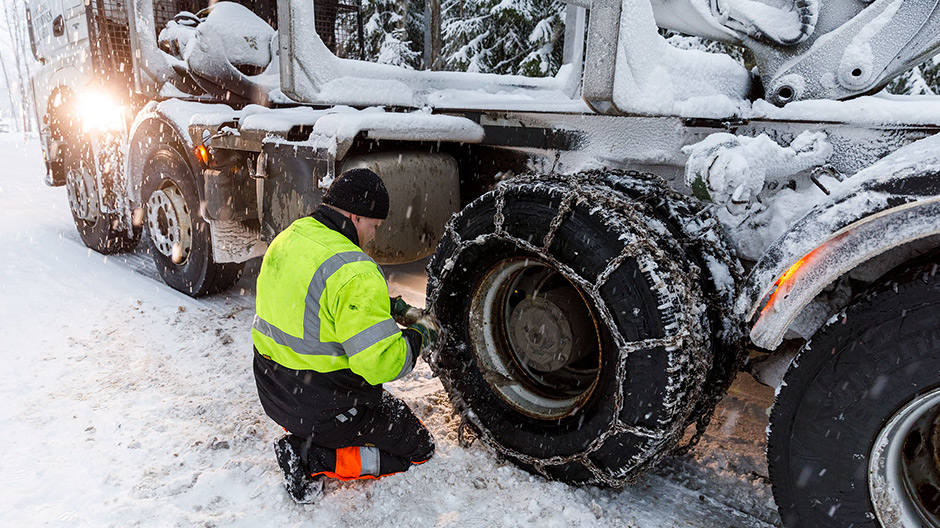
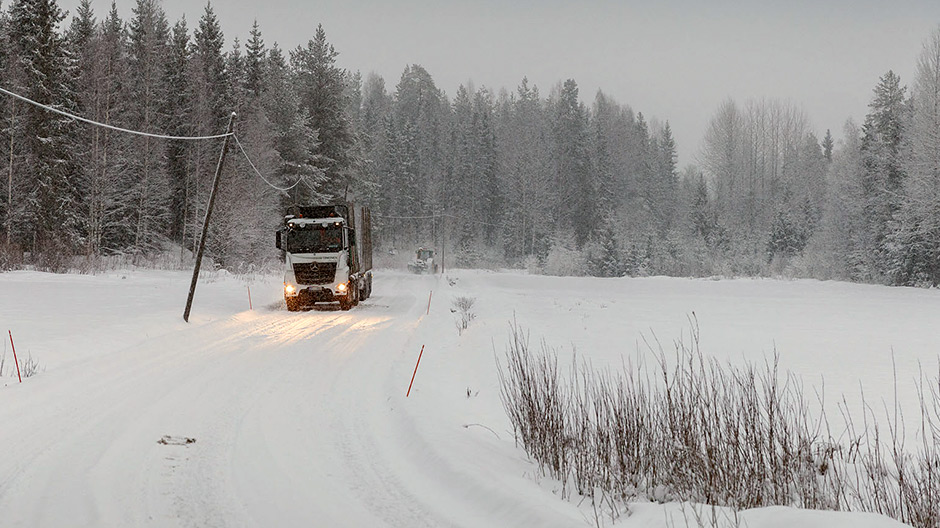
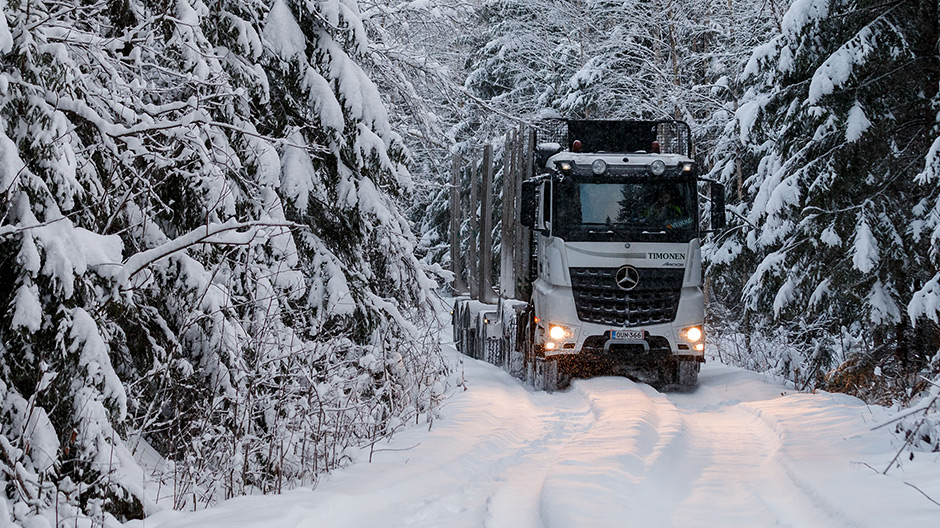
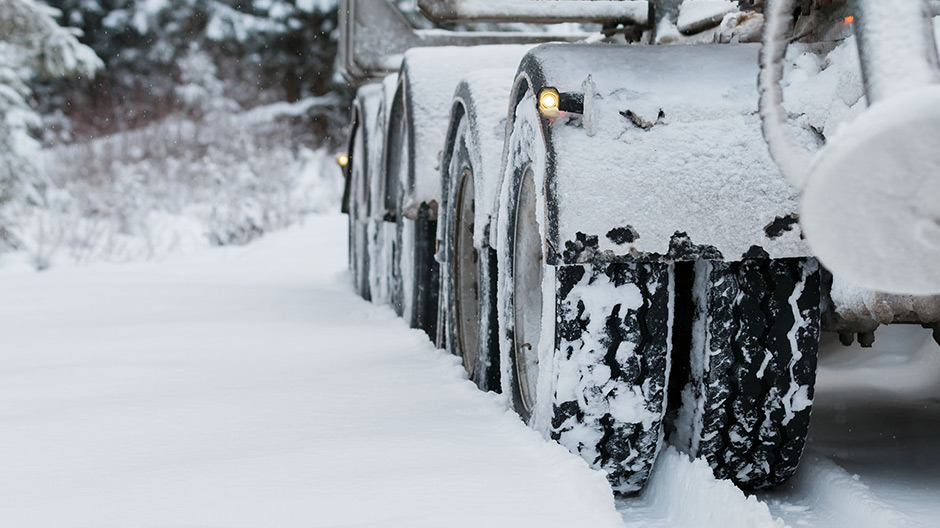
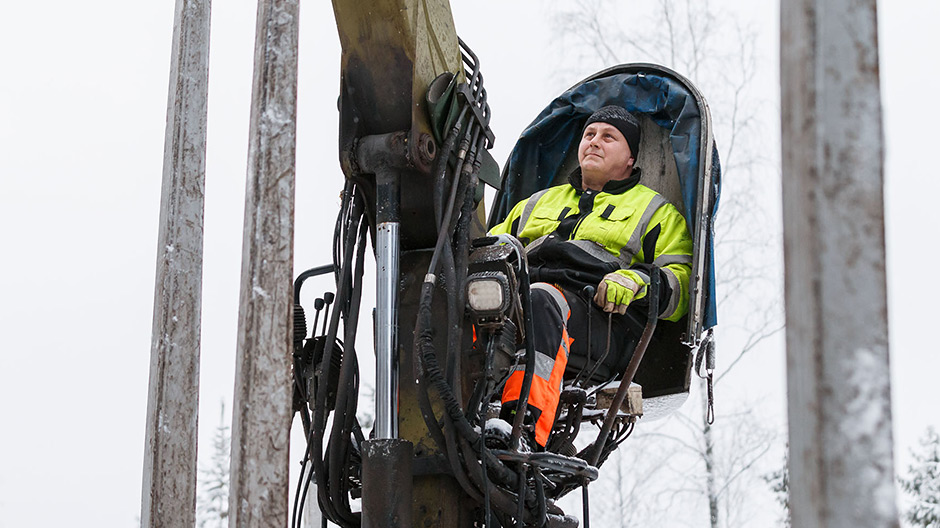
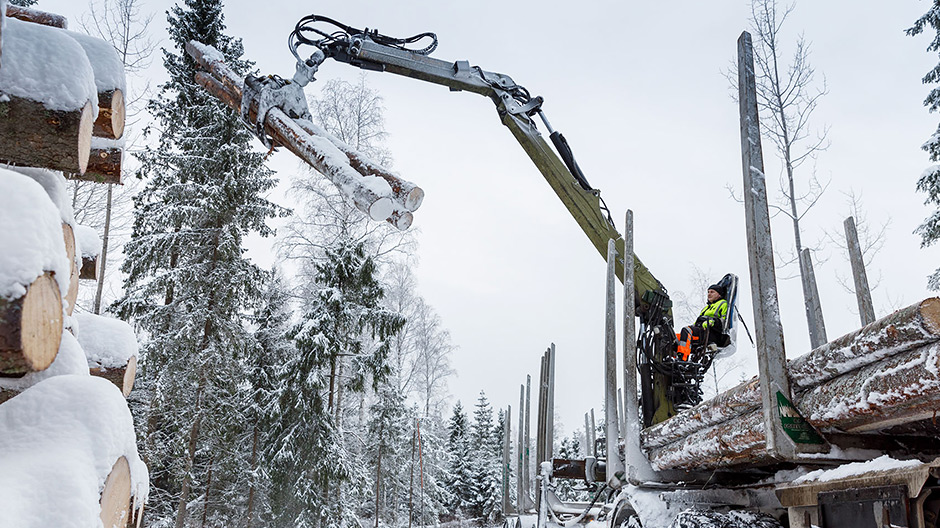
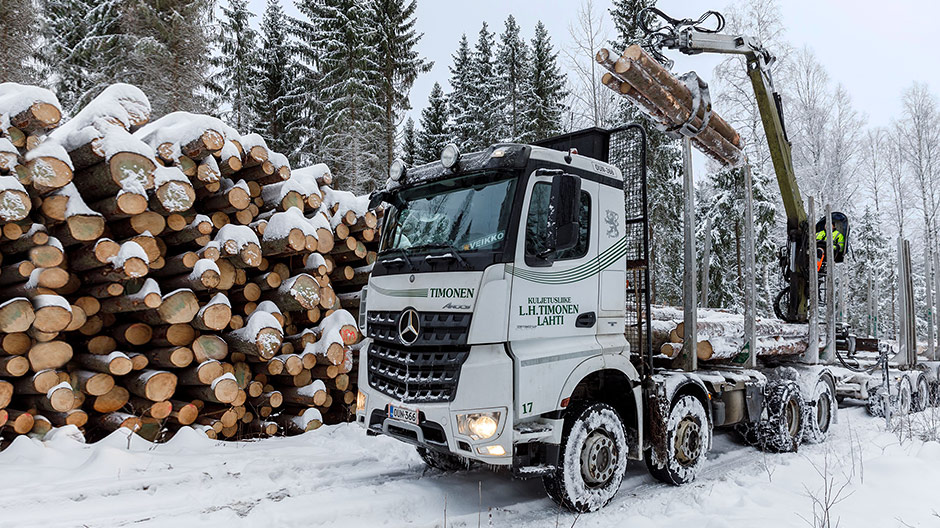
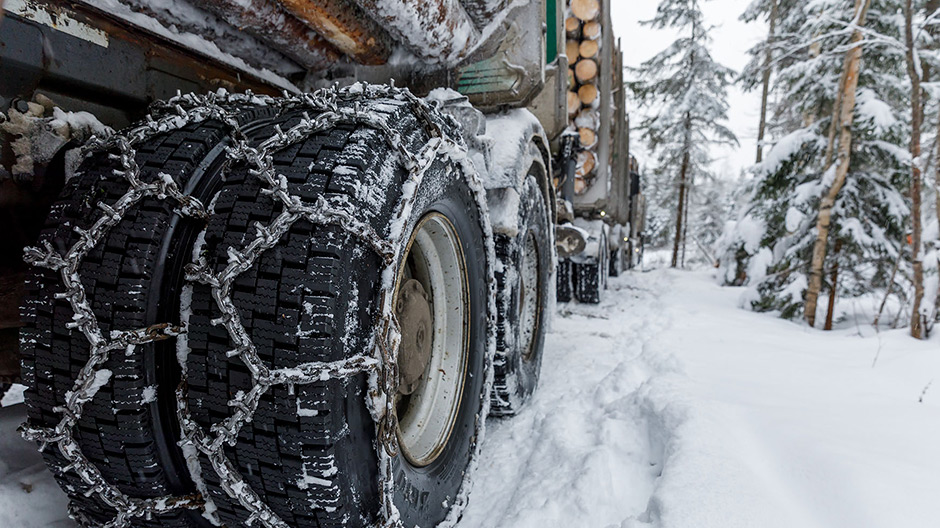
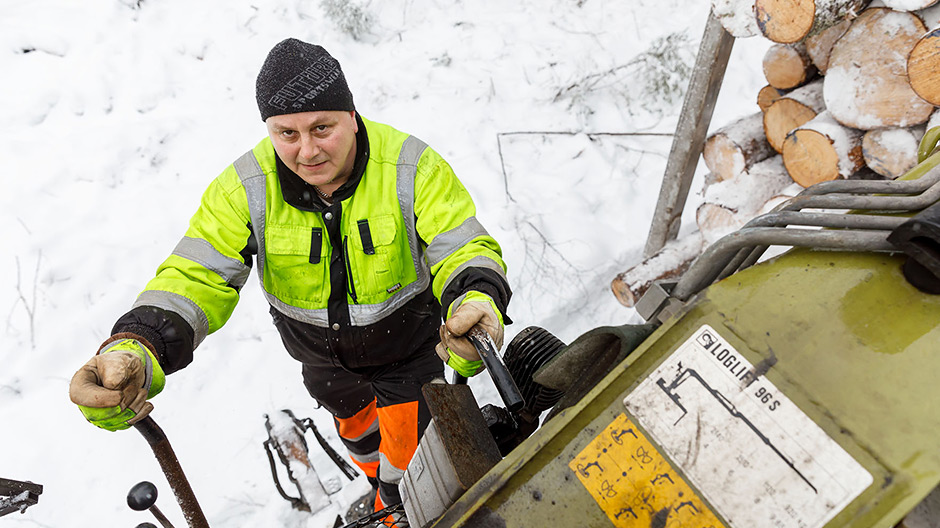
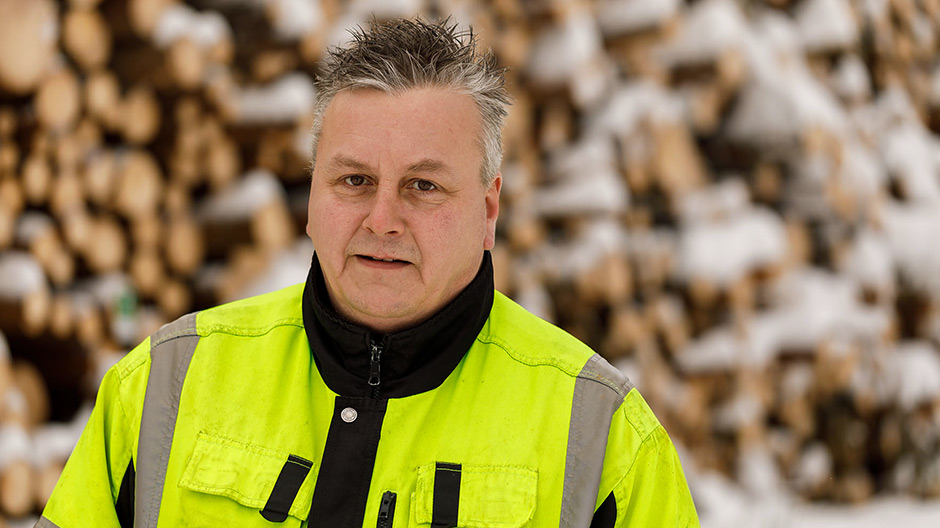
Veikko gets to work.
We continue in similar fashion for two kilometres – and then the woodpile becomes visible. Having been turned and parked in the tightest of spaces, the truck now stands alongside hundreds of cubic metres of top-notch fir, which will be cut into planks at the sawmill.
Veikko climbs onto the crane and gets to work. The hydraulic gripper can hold up to six logs at once. He manoeuvres each one of the 5.20-metre-long pieces of timber into a gap, as it’s important that all the logs are stowed securely during transit.
Veikko and his colleague Pete (who drove his Arocs into the forest at the same time) have soon loaded their cubic metres of timber. “You are very much on your own out here. When there’s two of you, you can help each other out,” says Veikko.
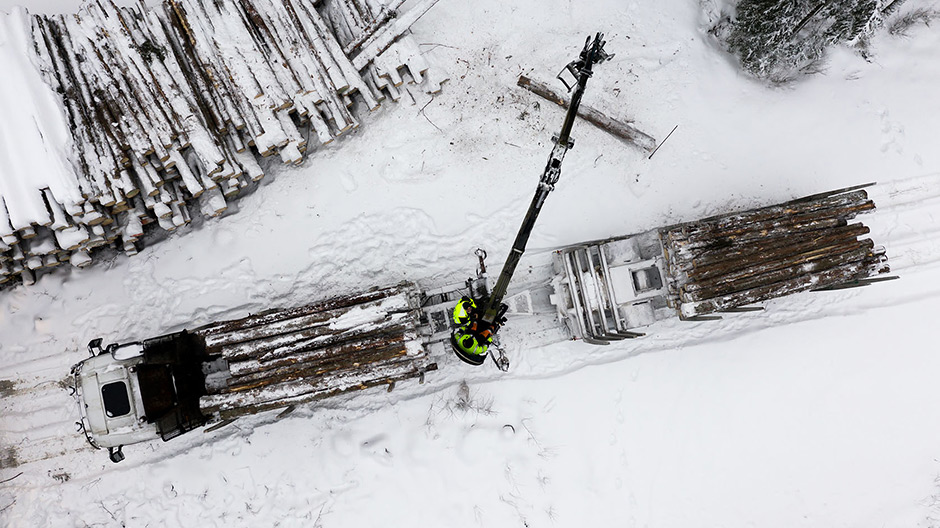
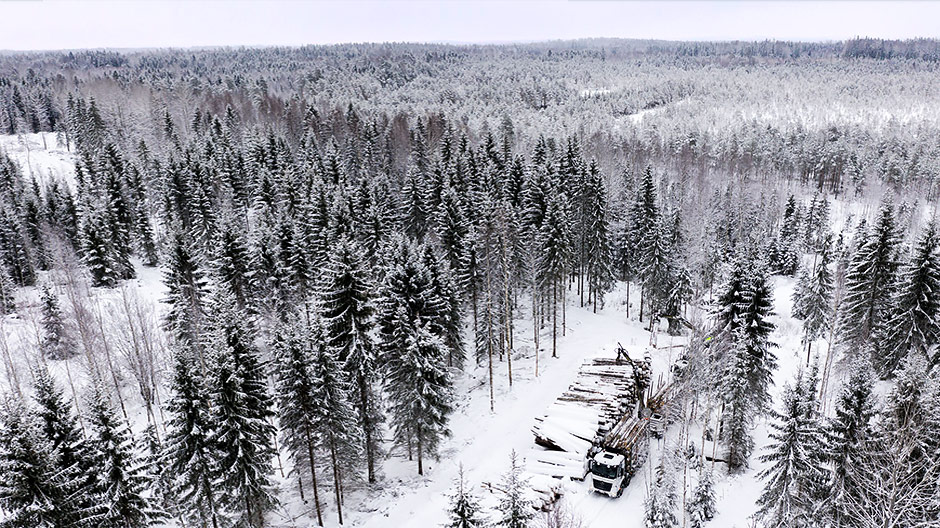
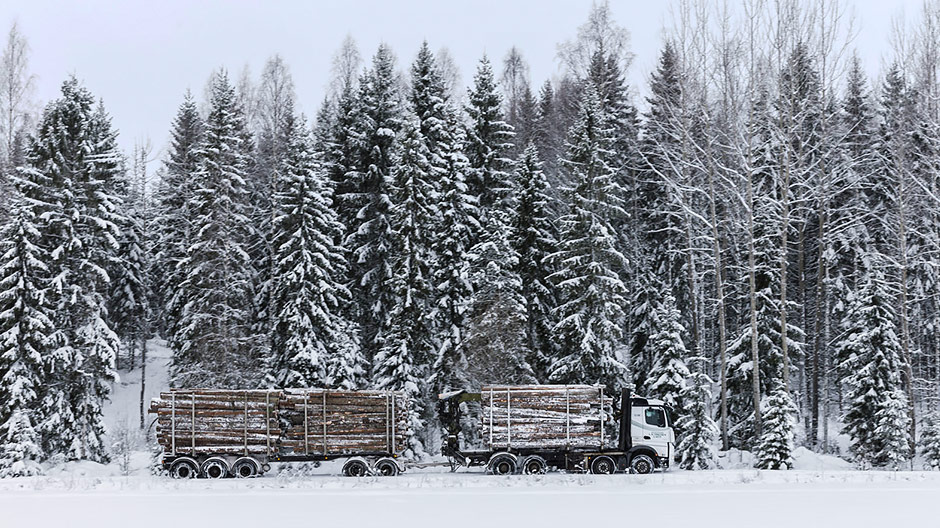
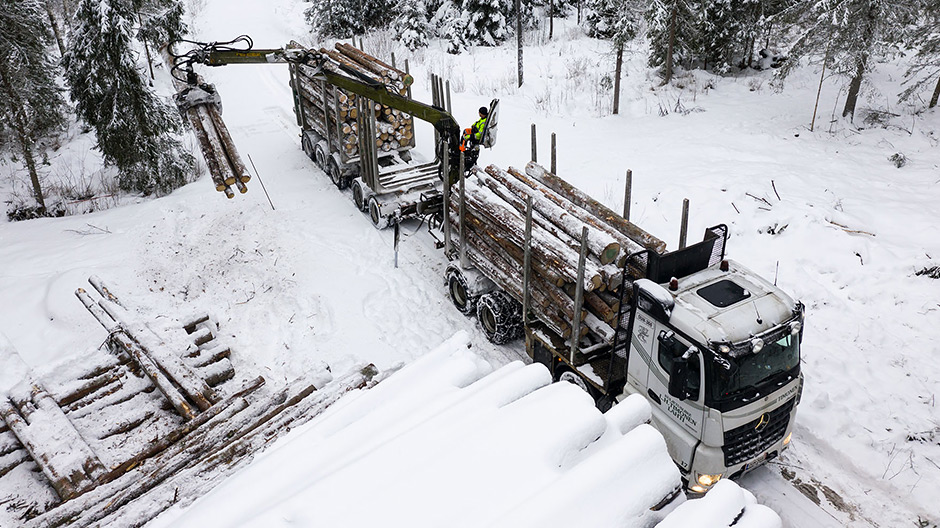
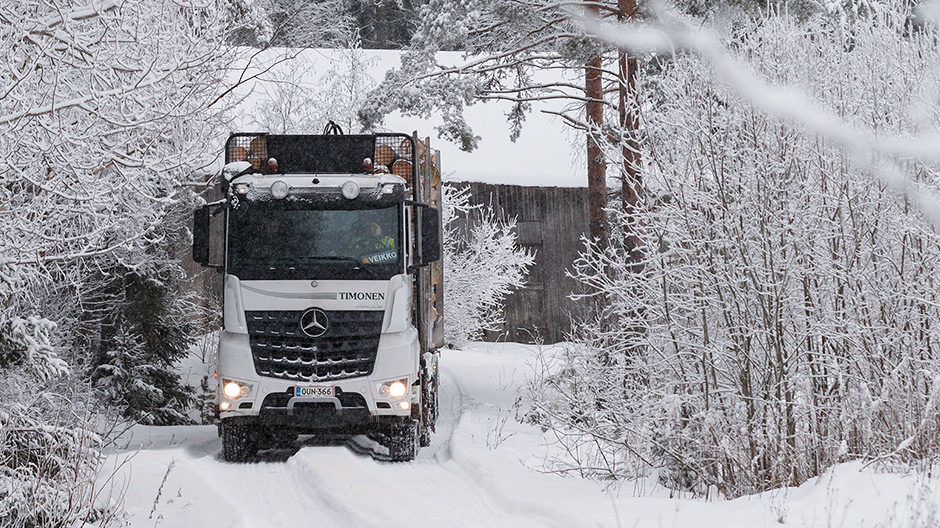
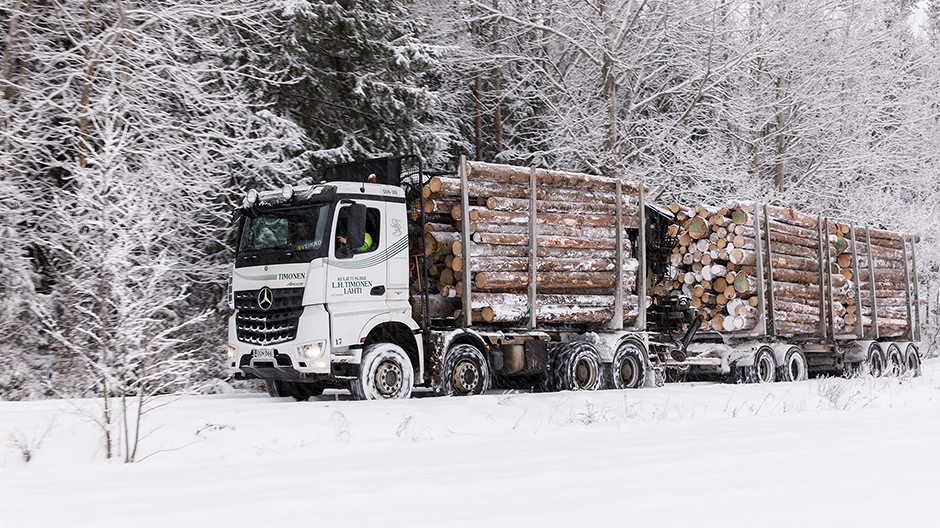
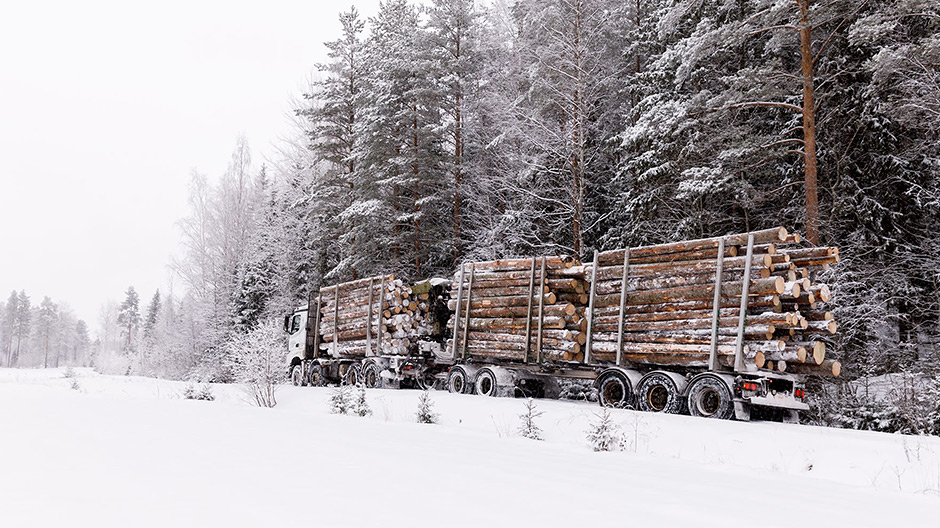
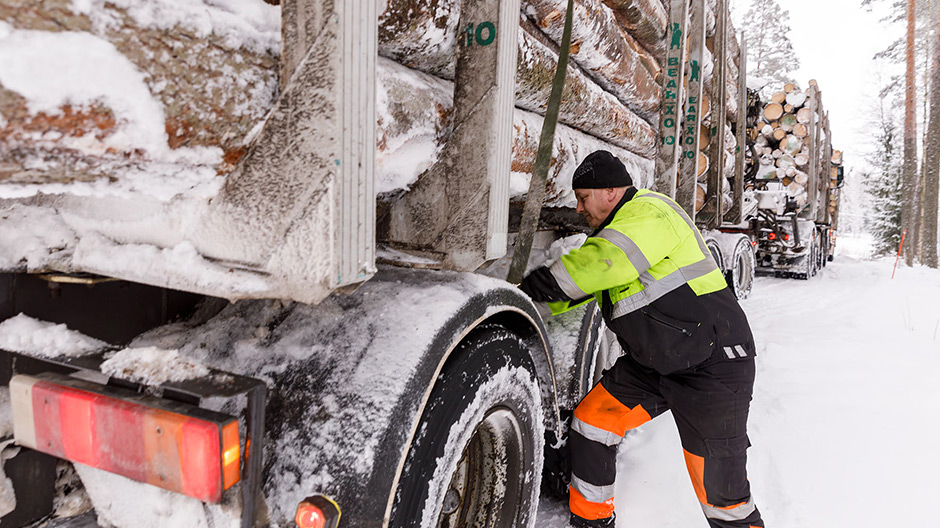
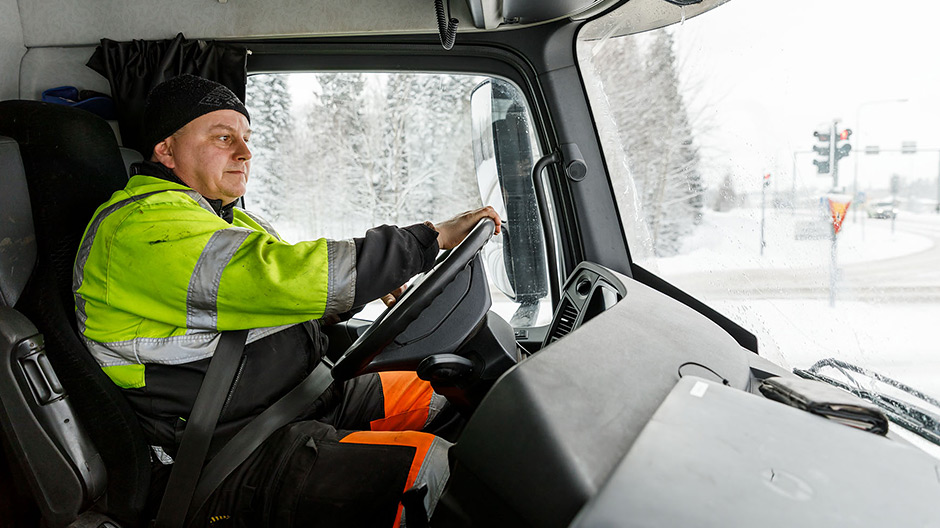
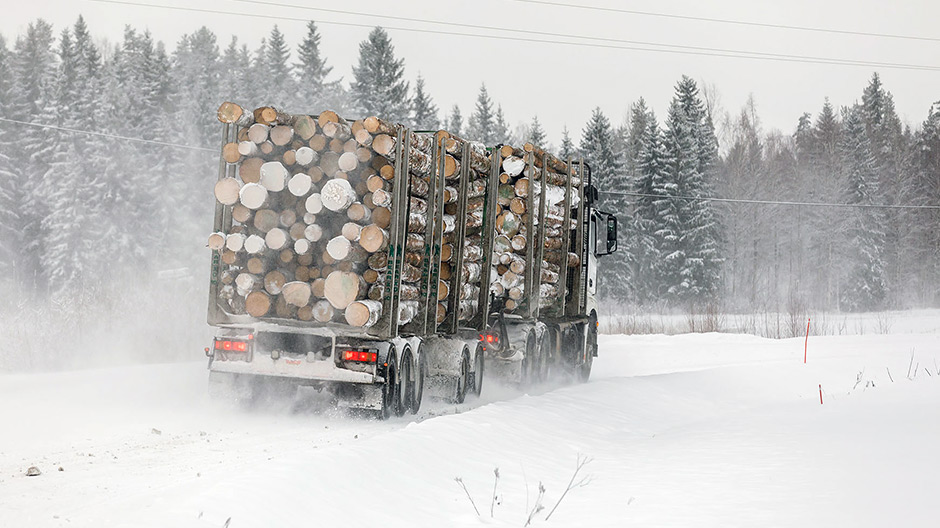
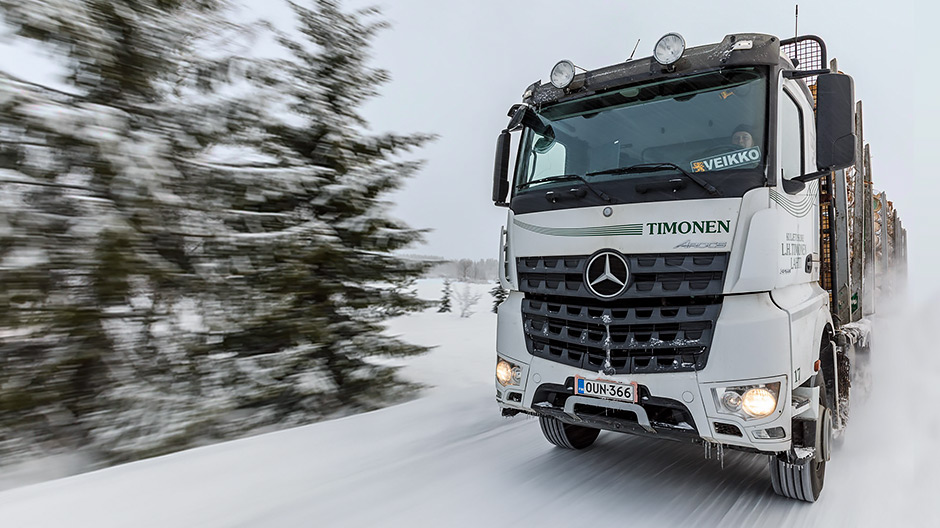
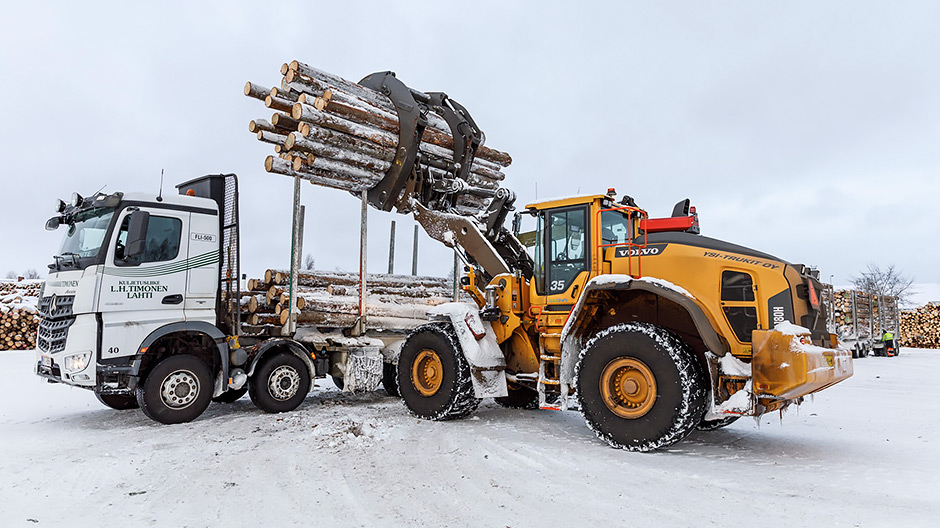
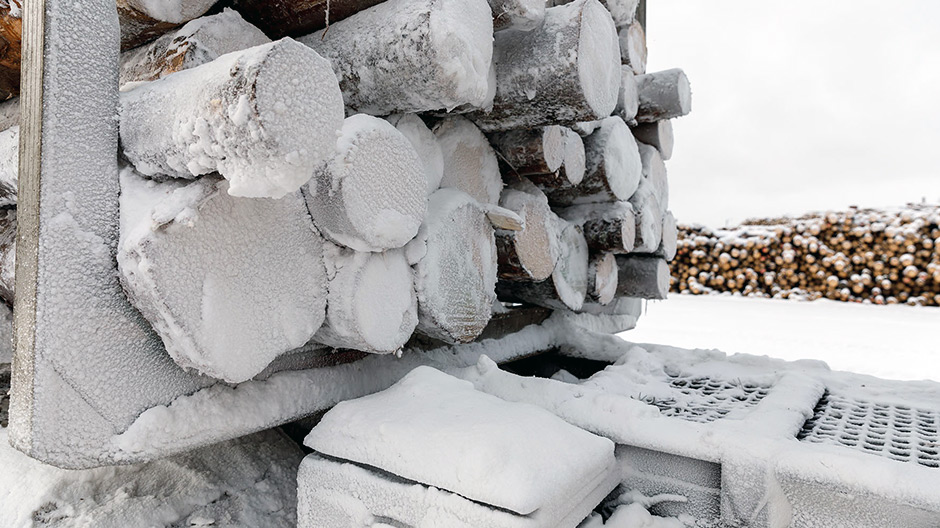
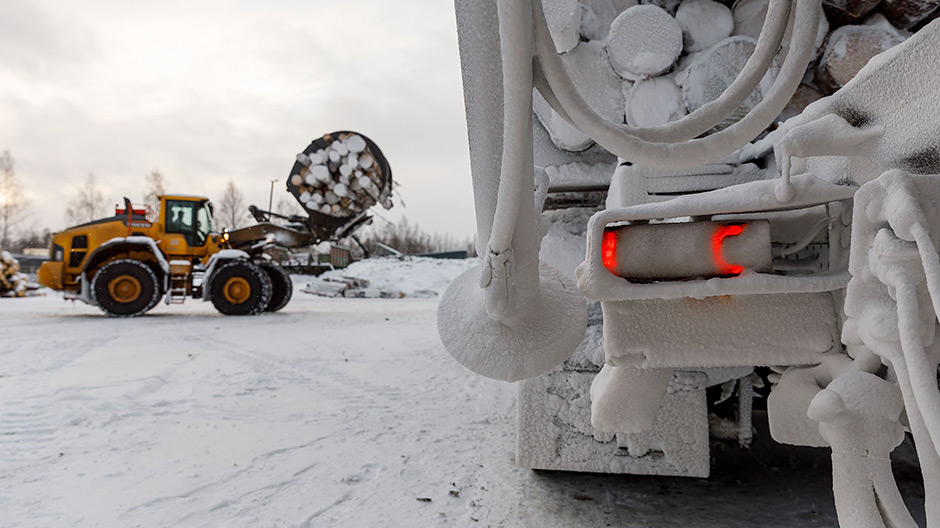
“I had always dreamt of Finland. And then the time really did come to start a new life.”
– Friedhelm Schäfer (Veikko)
Leaving the forest in a 76 tonne truck.
It’s time to go, but the truck now has 51 tonnes of timber on board and a total weight of 76 tonnes. Veikko changes gears, but only up into fifth. Nice and slow on this section, as there is a nasty incline up ahead, followed by a bend. He gently applies the brakes; truck and trailer stay nicely in line.
Veikko makes another short stop at the end of the forest trail, where he secures the logs in place. “Then the load sits better. And if the trailer slips into a ditch in the forest, all that happens is that the timber falls out. With a bit of luck, you can then put it back with your crane,” he explains.
Next stop: the sawmill. As it’s about a two-hour drive, we have a bit of time to think. What do you need to survive out here? Good winter tyres, snow chains and a liftable rear axle (so that you have enough weight to start on the axle with the chains). But just as important is the driver themselves. “You can’t afford to be afraid. You have to know when to slow down and you can’t brake too sharply. But the most important skill is being able to read the road. In Iserlohn, I was a good driver. Here, I started out as a novice,” says Veikko.
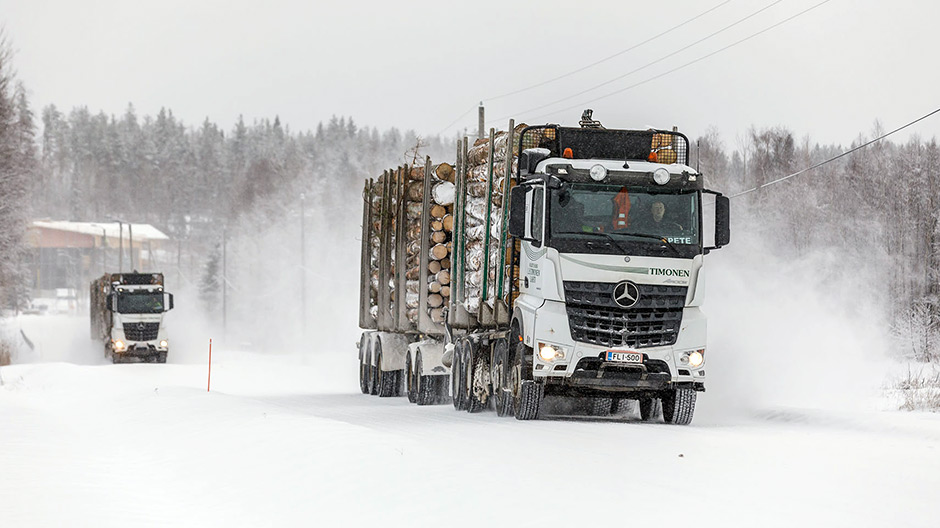
A new life.
Iserlohn, his home town in Germany, seems a lifetime away. Veikko arrived in Lahti ten years ago. As his mother is Finnish, he could speak a bit of the language and often stayed with his grandparents in the school holidays. “I had always dreamt of Finland. And then the time really did come to start a new life.” His sons – now aged 25 and 23 – followed him, and he now also has a seven-year-old son here.
“I never thought that it would be such hard work in winter. But it’s fun,” says Veikko. He finds the Finns welcoming, helpful and honest. “And whatever the weather, the traffic keeps moving.”
The sawmill in Riihimäki. Scales, unloading area – 20 minutes later, the truck is empty. The quality, weight and volume of the cargo are recorded immediately and confirmed to Veikko in an email. Once he has received this information, he marks the job as complete on his laptop in the cabin – and sets off again.
Photos: Christoph Börries
Video: Martin Schneider-Lau




Comment
Please log in to post a comment.
52 comments
Grüße aus der Heimat an dieser Stelle...😘👍
Grüße aus der Heimat an dieser Stelle...😘👍
Gutes neues jahr.
Gutes neues jahr.
Viel Spaß weiterhin, und Gesundheit das du deinen Traum noch lange weiter Leben kannst.
Viel Spaß weiterhin, und Gesundheit das du deinen Traum noch lange weiter Leben kannst.
Merry X-Mas and a happy new year!
Merry X-Mas and a happy new year!
Bitte teilen Sie mir Ihre Postanschrift mit.🎅🎄❄️📩
Bitte teilen Sie mir Ihre Postanschrift mit.🎅🎄❄️📩
Der Zuschnitt dieses Berichtes find' ich gut, etwas länger, etwas mehr Details, natürlich Bilder und wieder ein gelungenes Video...
Vielen Dank!
Gruß
Klaus
Der Zuschnitt dieses Berichtes find' ich gut, etwas länger, etwas mehr Details, natürlich Bilder und wieder ein gelungenes Video...
Vielen Dank!
Gruß
Klaus
Ich kann Friedhelm verstehen , ich fahre seit 40 Jahren nach Finnland . Wir haben dort auch schon einen Winter erlebt . 30-35 Grad minus und Schnee soweit das Auge reicht .
Und dann im Wald , da muss man alle Sinne beisammen haben , da darf nichts schiefgehen . Es kann u.U. dauern bis jemand kommt und hilft .
Auch danke an RoadStars für den Bericht .
Ich kann Friedhelm verstehen , ich fahre seit 40 Jahren nach Finnland . Wir haben dort auch schon einen Winter erlebt . 30-35 Grad minus und Schnee soweit das Auge reicht .
Und dann im Wald , da muss man alle Sinne beisammen haben , da darf nichts schiefgehen . Es kann u.U. dauern bis jemand kommt und hilft .
Auch danke an RoadStars für den Bericht .
Holz-/Langholztransporte und Schwertransporte in einem und bei diesen Straßen- bzw. Wetterverhältnissen ziehe ich meinen Hut vor Mensch und Maschine.
👍💪👍💪👍💪🤘⛟😎
Holz-/Langholztransporte und Schwertransporte in einem und bei diesen Straßen- bzw. Wetterverhältnissen ziehe ich meinen Hut vor Mensch und Maschine.
👍💪👍💪👍💪🤘⛟😎
#Trucks you can trust✌️
#Trucks you can trust✌️